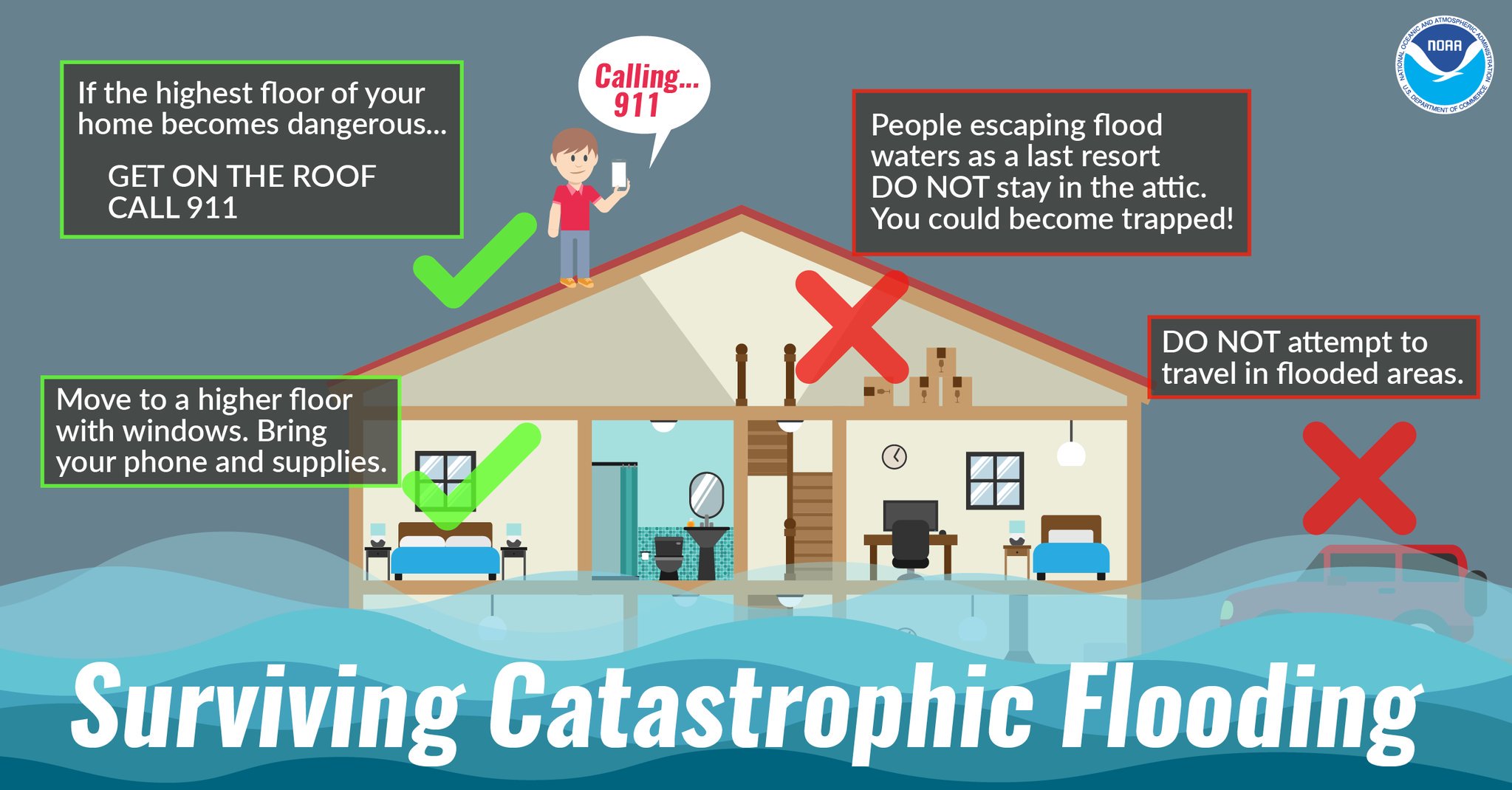How To Prepare For Flash Floods: Understanding Flood Warnings And Taking Action

Table of Contents
Understanding Flash Flood Warnings and Alerts
Flash floods develop rapidly, often within six hours or less of heavy rainfall. This rapid onset is what makes them so dangerous. Therefore, understanding and responding quickly to flash flood warnings is paramount. Different warning systems are in place to alert you to impending danger. These include:
- Weather alerts: These are typically issued by national meteorological services and delivered via weather apps, television, radio, and online sources. Look for terms like "flash flood warning," "flash flood watch," and "flash flood emergency." A watch means conditions are favorable for a flash flood, while a warning indicates a flash flood is occurring or is imminent. An emergency signifies an extremely dangerous situation requiring immediate action.
- Sirens: Many communities utilize outdoor warning sirens to alert residents of imminent danger, including flash floods. Familiarize yourself with the sound of your local sirens and what actions to take when you hear them.
- Local news: Stay informed by monitoring local news channels, radio stations, and websites for up-to-date information about weather conditions and flash flood warnings in your area.
It's vital to:
- Sign up for emergency alerts on your phone and computer. Many services allow you to customize alerts based on your location.
- Know the different levels of flood warnings (watch, warning, emergency) and understand what actions each level requires.
- Monitor weather forecasts regularly, especially during periods of heavy rainfall, intense thunderstorms, or when a flash flood watch is issued.
- Understand your local flood risk areas. Identify areas prone to flash flooding in your community and plan accordingly. Many local governments provide flood risk maps online.
- Know your evacuation routes. Familiarize yourself with designated evacuation routes and have alternate routes planned in case of road closures.
Never wait for visible flooding before taking action. By the time you see the water, it may be too late to escape safely.
Preparing Your Home for Flash Floods
Protecting your property from flash flood damage involves several proactive steps. These include:
- Elevate valuable items and appliances: Move important documents, electronics, and other valuable items to higher floors or shelves.
- Develop a plan to move furniture and other valuables to upper floors: This includes heavy furniture that could be damaged or cause further damage.
- Clear gutters and drains: Regularly cleaning gutters and downspouts ensures that water flows away from your home, preventing water buildup around the foundation.
- Install flood barriers or sandbags: Consider purchasing and installing flood barriers or sandbags around your property's perimeter to help divert floodwaters. This is particularly crucial for homes in low-lying areas.
- Consider flood insurance: Flood insurance is essential to protect your financial investment in your home and possessions. Standard homeowner's insurance policies typically do not cover flood damage.
Furthermore, create a comprehensive emergency kit that includes:
- Water: A minimum of one gallon of water per person per day for at least three days.
- Food: Non-perishable, easy-to-prepare foods.
- Medications: A seven-day supply of any necessary medications.
- First-aid kit: Include essential supplies for treating minor injuries.
- Flashlight and extra batteries: Essential for navigating in the dark.
- Radio: A battery-powered or hand-crank radio for receiving emergency broadcasts.
- Important documents: Copies of insurance policies, identification, and other important documents stored in a waterproof container.
Creating a Flash Flood Emergency Plan
Having a well-defined evacuation plan is crucial for your family's safety. This plan should include:
- Identifying multiple escape routes from your home: Plan for different escape routes in case one becomes blocked by floodwaters.
- Determining a designated meeting place for family members: Choose a location outside your home where everyone can meet in case of separation.
- Packing an emergency go-bag: This bag should contain essential supplies, including water, food, medications, and other necessities. Keep this bag readily accessible.
- Knowing your local evacuation shelters: Familiarize yourself with the locations of designated evacuation shelters in your area.
- Practicing your evacuation plan with your family: Regularly practice your plan to ensure everyone knows what to do in an emergency.
During a flash flood:
- Seek higher ground immediately. Move to higher ground as quickly and safely as possible.
- Avoid floodwaters. Floodwaters can be swift, deep, and contain hidden dangers like debris and downed power lines. Never attempt to drive or walk through floodwaters.
- Turn off all utilities if instructed to do so. This reduces the risk of electrical shock and further damage to your home.
- Stay informed: Continuously monitor emergency broadcasts for updates and instructions.
Protecting Your Family During a Flash Flood
Staying informed and acting quickly is paramount to protecting your family during a flash flood. Never compromise safety. Remember:
- Never drive through flooded areas. Floodwaters can be deceivingly deep and fast-moving, easily sweeping vehicles away.
- Avoid walking or playing in floodwaters. Floodwaters are often contaminated with sewage, chemicals, and debris, posing serious health risks.
- Turn off all utilities if instructed to do so.
- Stay away from downed power lines. Downed power lines pose a severe electrocution risk.
- Be aware of the dangers of contaminated water. Avoid contact with floodwaters as much as possible.
Always follow instructions from emergency services. They are best equipped to guide you to safety.
Conclusion
Flash floods are a serious threat, but by understanding flash flood warnings and implementing a comprehensive preparation plan, you can significantly reduce your risk. Remember to stay informed, create a detailed emergency plan, and protect your home and family. Don't wait for a flash flood to strike – take action today and prepare your home and loved ones against the devastating effects of flash floods. Learn more about flash flood safety and preparedness in your area by contacting your local emergency management agency. Prepare for flash floods now and safeguard your future.

Featured Posts
-
 New Insights Into Sixth Century Burial Rituals The Sutton Hoo Vessel And Cremated Remains
May 25, 2025
New Insights Into Sixth Century Burial Rituals The Sutton Hoo Vessel And Cremated Remains
May 25, 2025 -
 Los Mellizos De Alberto De Monaco Celebran Su Primera Comunion
May 25, 2025
Los Mellizos De Alberto De Monaco Celebran Su Primera Comunion
May 25, 2025 -
 Jejak Porsche 356 Dari Zuffenhausen Ke Legenda Otomotif Jerman
May 25, 2025
Jejak Porsche 356 Dari Zuffenhausen Ke Legenda Otomotif Jerman
May 25, 2025 -
 Goodwood Motor Circuit Welcomes Oxfordshire Teenager Inspired By F1
May 25, 2025
Goodwood Motor Circuit Welcomes Oxfordshire Teenager Inspired By F1
May 25, 2025 -
 Popular Southern Vacation Area Fights Back Against Negative Safety Report After Violence
May 25, 2025
Popular Southern Vacation Area Fights Back Against Negative Safety Report After Violence
May 25, 2025
